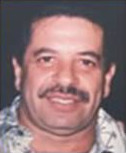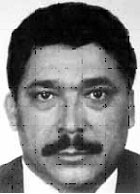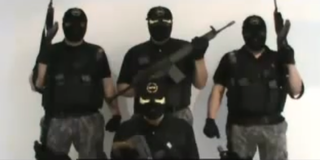Related Research Articles
A drug cartel is a criminal organization composed of independent drug lords who collude with each other in order to improve their profits and dominate the illegal drug trade. Drug cartels form with the purpose of controlling the supply of the illegal drug trade and maintaining prices at a high level. The formations of drug cartels are common in Latin American countries. Rivalries between multiple drug cartels cause them to wage turf wars against each other.
The Norte del Valle Cartel, or North Valley Cartel, was a drug cartel that operated principally in the north of the Valle del Cauca department of Colombia, most notably the coastal city of Buenaventura. It rose to prominence during the 1990s, after the Cali and Medellín Cartels fragmented, and it was known as one of the most powerful organizations in the illegal drug trade. The drug cartel was led by the brothers Luis Enrique and Javier Antonio Calle Serna, alias "Los Comba", until its takedown in 2008 by the authorities of Colombia and Venezuela, with cooperation of the United States DEA.
The Middle Magdalena Bloc of the FARC-EP was a FARC-EP bloc, notable for its involvement in the conflict with the AUC until the latter's demobilization in 2004. After that, it became one of the Colombian army's biggest worries as FARC started once again to gain control over the territory.

The Mexican drug war is an ongoing asymmetric armed conflict between the Mexican government and various drug trafficking syndicates. When the Mexican military intervened in 2006, the government's main objective was to reduce drug-related violence. The Mexican government has asserted that their primary focus is dismantling the cartels and preventing drug trafficking. The conflict has been described as the Mexican theater of the global war on drugs, as led by the United States federal government.

Bernardo Jaramillo Ossa was a Colombian politician and member of the Colombian Communist Party. Jaramillo started working primarily in the Urabá Antioquia region until 1987 when he assumed the presidency of the Patriotic Union Party (UP) after the assassination of Jaime Pardo.

Carlos Alberto "Beto" Rentería Mantilla was a former Colombian narcotrafficker and crime boss, presumed leader of the Norte del Valle Cartel. Rentería was believed by the United States government to be holding a leadership position within the drug cartel, he had been labeled "one of Colombia's most powerful and sophisticated narcotics traffickers" by Adam Szubin, Director of the Office of Foreign Assets Control, United States Department of the Treasury. The Attorney General of Colombia and the Colombian National Police accuse Rentería of drug trafficking and money laundering.

Wilber Alirio Varela Fajardo, also known as Jabón ("Soap"), was a Colombian drug trafficker. He was the leader of the Norte del Valle Cartel. A Racketeer Influenced and Corrupt Organizations Act indictment was filed in the District Court of the District of Columbia by the Narcotics and Dangerous Drugs Section of the United States Department of Justice Criminal Division against the leaders of the Norte del Valle Cartel, including Varela. According to the indictment, the Norte del Valle Cartel exported approximately 500 metric tons of cocaine worth over $10 billion from Colombia to the United States, often through Mexico, between 1990 and 2004. The indictment was unsealed in May 2004. A provisional arrest warrant was issued and was sent to the U.S. Embassy in Bogotá.

Sandra Ávila Beltrán is a Mexican drug lord, dubbed "La Reina del Pacífico" by the media. She was arrested on September 28, 2007, and was charged with organized crime and conspiracy to drug trafficking. Some charges were later dropped but she was still held on possession of illegal weapons and money laundering, pending her extradition to the United States. On August 10, 2012, she was extradited to the United States to answer to criminal charges by the U.S. government.
Jorge Enrique Rodríguez Mendieta known by his nom de guerre Iván Vargas is a Colombian guerrilla leader member of the Revolutionary Armed Forces of Colombia (FARC-EP), former commander of the 24th Front of the Middle Magdalena Bloc of the FARC-EP. Vargas was arrested in late 2004 in the city of Bucaramanga by Colombian authorities and extradited to the United States on 3 November 2007 on charges of narcotrafficking.
The timeline of some of the most relevant events in the Mexican drug war is set out below. Although violence between drug cartels had been occurring for three decades, the Mexican government held a generally passive stance regarding cartel violence through the 1980s and early 2000s.

Roberto Suárez Gómez, also known as the King of Cocaine, was a Bolivian drug lord and trafficker who played a major role in the expansion of cocaine trafficking in Bolivia. In his prime, Suárez made $400 million annually, was one of the major suppliers of the Medellín Cartel as well as the leader of the largest Bolivian drug empire, and was considered to be the biggest cocaine producer in the world.

Cárteles Unidos, also known as La Resistencia is a Mexican criminal enforcer squad composed of well-trained gunmen from the Sinaloa Cartel, Gulf Cartel, La Familia Michoacana, and Knights Templar Cartel originally formed to expel the Los Zetas Cartel from the states of Michoacán and Jalisco. However, Cárteles Unidos' current main rival has now become the Jalisco New Generation Cartel; a paramilitary criminal organization based in the neighboring state of Jalisco.

The Clan del Golfo, also known as Gaitanist Self-Defense Forces of Colombia and formerly called Los Urabeños and Clan Úsuga, is a prominent Colombian neo-paramilitary group and currently the country's largest drug cartel.

Gustavo de Jesús Gaviria Rivero was a Colombian drug trafficker. As Pablo Escobar's cousin and right-hand man, Gaviria controlled the Medellín cartel's finances and trade routes. He and Escobar had collaborated in their criminal careers since the early 1970s.

Jaime Ramírez Gómez was an official of the National Police of Colombia, who led a fight against the illegal drug trade in Colombia from the 1970s onwards.

Nemesio Rubén Oseguera Cervantes, commonly referred to by his alias El Mencho, is a Mexican drug lord and leader of the Jalisco New Generation Cartel (CJNG), an organized crime group based in Jalisco. He is the most-wanted person in Mexico and one of the most-wanted in the U.S. The US government, as well as the Mexican government, is offering $10 million and $30 million respectively for information leading to his arrest.

Érick Valencia Salazar, commonly referred to by his alias El 85, is a Mexican drug lord and high-ranking leader of the Nueva Plaza Cartel. He previously served as a high-ranking leader of the Jalisco New Generation Cartel (CJNG), a criminal group based in Jalisco. The Mexican Army suspects he was responsible for supervising the CJNG's cocaine and ephedrine delivery shipments from Colombia and China to Mexico, and for coordinating attacks against rival groups like La Resistencia and Los Zetas in the 2010s. Before leading the CJNG, Valencia reportedly held a leadership role within the Milenio Cartel, the predecessor group where the CJNG originated from. When several of his superiors were arrested and/or killed, Valencia and several others from the Milenio Cartel reportedly formed the CJNG.
José González Valencia is a Mexican suspected drug lord and high-ranking leader of the Jalisco New Generation Cartel (CJNG), a criminal group based in Jalisco. He is part of a clan that heads a CJNG money laundering branch known as Los Cuinis. Since 2015, González Valencia reportedly held a leading role within the CJNG as the security chief of Nemesio Oseguera Cervantes, the top leader of the criminal group. Security forces in the U.S. and Mexico suspect he was also responsible for coordinating drug trafficking operations from Mexico to the U.S., Asia, and Europe.
The Chapare Drug Cartel is a Bolivian criminal organization dedicated to drug trafficking and human trafficking that operates in the Chapare region. For this, several journalists have baptized this organization simply as the Chapare Cartel
References
- ↑ "Narco Jets and Police Protection in Bolivia". December 1997.
- "Drugs and Democracy | Narco Jets and Police Protection in Bolivia". tni.org. Retrieved 2014-01-26.
- RADIO PATRIA NUEVA - BOLIVIA. "Radio Patria Nueva – Noticia". patrianueva.bo. Archived from the original on 2014-02-03. Retrieved 2014-01-26.
- "noticias/actualidad/narcotraficante-boliviano-detenido-en-paraguay/20071216/nota/520929". Archived from the original on 2013-06-16. Retrieved 2014-01-26.
- "García: Evo heredó un Gobierno penetrado por el narcotráfico". opinion.com.bo. Retrieved 2014-01-26.
- "EN DESBANDADA MAFIA DEL VALLE - Archivo - Archivo Digital de Noticias de Colombia y el Mundo desde 1.990 - eltiempo.com". eltiempo.com. 20 February 1994. Retrieved 2014-01-26.